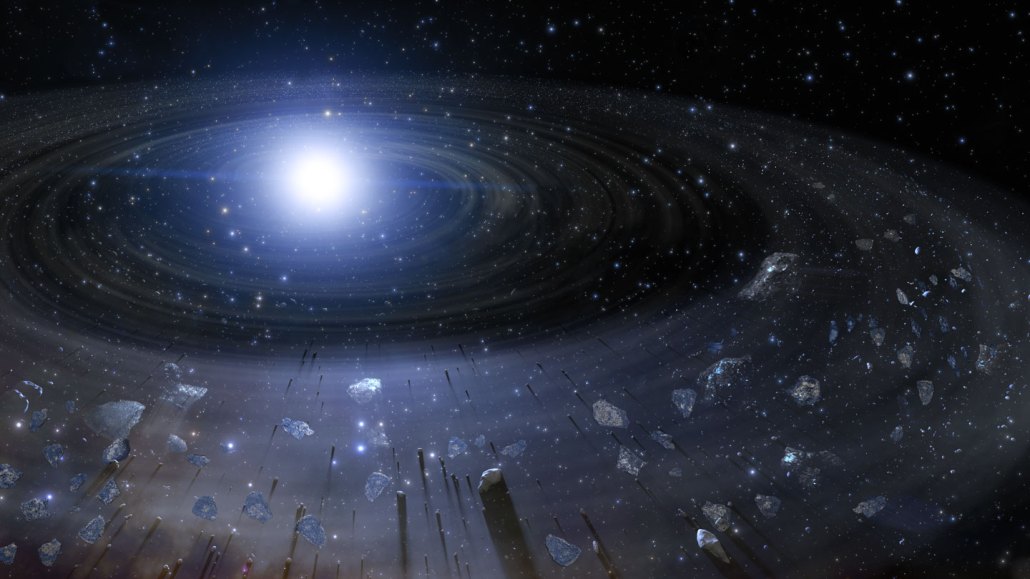
Debris from a destroyed rocky planet (illustrated) circles and falls onto a white dwarf star. A new study of these stars finds that most of their planets differed greatly from the rocky planets orbiting the sun.
J. da Silva, NOIRLab/AURA and NSF
If a real Captain Kirk ever blasts off for other stars in search of rocky planets like ours, he may find lots of strange new worlds whose innards actually bear no resemblance to Earth’s.
A smattering of heavy elements sprinkled on 23 white dwarf stars suggests that most of the rocky planets that once orbited the stars had unusual chemical makeups, researchers report online November 2 in Nature Communications. The elements, presumably debris from busted-up worlds, provide a possible peek at the planets’ mantles, the region between their crust and core.
“These planets could be just utterly alien to what we’re used to thinking of,” says geologist Keith Putirka of California State University, Fresno.
But deducing what a long-gone planet was made of from what it left behind is fraught with difficulties, cautions Caltech planetary scientist David Stevenson. Rocky worlds outside of the solar system may have exotic chemical compositions, he says. “It’s just that I don’t think this paper can be used to prove that.”
After a star like the sun expands into a red giant star, it ultimately blows off its atmosphere, leaving behind its small, dense core, which becomes a white dwarf. That star’s great gravity drags heavy chemical elements into its interior, so most white dwarfs have pristine surfaces of hydrogen and helium.
But more than a quarter of these stars sport surfaces with heavier elements such as silicon and iron, presumably from planets that once circled the star and met their ends when it expanded into a red giant (SN: 8/15/11). The heavy elements on these white dwarfs haven’t yet had time to sink beneath the stellar surface.
For that reason, Siyi Xu, an astronomer at the Gemini Observatory in Hilo, Hawaii, has long studied white dwarfs. Then she met Putirka. Because he’s a geologist, “he was like, ‘Oh! We can look at this problem from a new perspective,’” Xu says.
Xu had been measuring the abundances of chemical elements littered on white dwarfs by studying the wavelengths of light, or spectra, given off by the stars. Putirka realized that those measurements could indicate what rocks and minerals had made up the destroyed planets’ mantles, which constitute the bulk of a small planet’s rock, because different rocks and minerals contain different chemical elements.
By examining white dwarfs within 650 light-years of the sun, Putirka and Xu reached a startling conclusion about the ripped-apart rocky planets. Contrary to conventional wisdom, most of their planetary mantles didn’t resemble those of the sun’s rocky planets — Mercury, Venus, Earth and Mars, the researchers say.
For example, some of the white dwarfs have lots of silicon. That suggests that their planets’ mantles had quartz — a mineral that in its pure form consists solely of silicon and oxygen. But there’s little, if any, quartz in Earth’s mantle. A planet with a quartz-rich mantle would probably differ greatly from Earth, Putirka says.
Such exotic mineral compositions might affect, for example, volcanic eruptions, continental drift and the fraction of a planet’s surface that consists of oceans versus continents. And all those phenomena might affect the development of life.
Stevenson, however, is skeptical of the new finding. When you measure the elemental composition of a “polluted white dwarf,” he says, “you do not know how to connect those numbers to what you started with.”
That’s partly because the destruction of rocky worlds around sunlike stars is complicated, Stevenson says. The planets first get blasted by the red giant’s bright light. Then they may get engulfed by the star’s expanding atmosphere and may even crash into another planet.
Each of these traumatic events could alter a planet’s elemental makeup, as well as possibly send some elements toward the white dwarf ahead of others. As a result, the planetary remains that end up on the star’s surface at one snapshot in time may not reflect the world’s starting composition.
Xu agrees that astronomers don’t know precisely how the breakup plays out or which elements wind up falling onto the white dwarf. Future theoretical studies could provide insight into the matter, she says.
She also notes that astronomers have caught asteroids disintegrating around white dwarfs, which offer a small window into the actual breakup process. And future observations of these white dwarfs, she says, could help reveal any changes in elemental composition over time.







